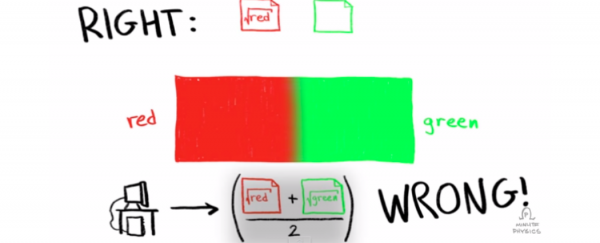I don't think I have to convince any of you that computers are pretty awesome. There aren't a whole lot of things they're not very good at, except maybe emotions and jokes. They're terrible at telling jokes. Another thing they're not great at? Blending colours, according to the latest episode of MinutePhysics.
You can try this at home - if you put a colourful image into Photoshop or Instagram and try to blur it, you'll see a weird dark band form between adjacent bright colours. If you blurred these colours by, say, putting on the wrong type of glasses, you wouldn't get this strange dark band, you'd just see a perfect blur. So what's going on here?
According to the video above, there's a very simple, scientific reason for what's going on, and an even simpler way to fix it. It all starts with how we perceive bright colours. "Human vision, like our hearing, works on a relative, roughly logarithmic scale," says Henry from MinutePhysics. "This means that flipping from one light to two changes the perceived brightness a tonne more than going from 101 to 102, despite adding the same physical amount of light."
This means our eyes and brains are even better than the processing power of computers at detecting the absolute darkness in bright scenes, but we're not so good at picking up on the brightness in dark scenes. Computers process light and colours in a completely different way - they detect brightness based purely on the amount of photons hitting a photodetector, says the episode of MinutePhysics above. And this can cause a whole lot of weird colour problems when you try to process an image.
I'll let Henry explain above, because the visuals really help. And it's worth it, because he knows how to fix the problem.
Source: MinutePhysics
